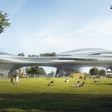
The Wi-Fi green station on the most prestigious Paris avenue, the Champs-Élysées, a clover-like shaped solar-powered street lamp and a plant air purifier, which we admired in his bright, new studio in the middle of Paris, are only a few stones in a rich mosaic of successful projects and products that have enthralled the world.
Lehanneur has worked for renowned brand names, such as Issey Miyake, Nike, Veuve Clicquot, Cartier, Christofle and others. He's a recipient of numerous design awards and, as of last year, he prides himself on becoming the chief designer for one of the world's leading manufacturers of smartphones, the Chinese giant, Huawei. Early on, he aspired to become a visual artist, but ended up studying design that spurred his creative projects with a vision to improve the users' quality of life.
With welfare in mind, you created a plant air filter called Andrea, where nature intertwines with technology. A piece of furniture which we'd be happy to display either in our living room or at our bedside. Are we talking about an indoor air purifier?
Yes. The air filter uses plant efficacy, in combination with the internal ventilator, which enables the air indoors to circulate. People aren't sufficiently aware that there's a whole lot of invisible interior pollutants found in materials which we are constantly exposed to, every single day. Plastic, paint, cleaning agents, objects and substances that have no odor, but are toxic to inhale. The solution is the Andrea air filter, which was awarded as the best innovation in 2009 by Popular Science magazine, and is now showcased in the permanent collection of the New York Museum of Modern Art. A single air purifier will be sufficient for a 40 square meter space, and the greener your plant, the better.

Last year you also participated at the COP21, the Paris conference on climate change, where you introduced yourself with an innovative urban project, the Clover solar-powered street lights.
The Clover is a unique hybrid. A hybrid of light, benches and seats, a hybrid of solar cells and wood, a piece which will bring nature into the city. It is made of carved-out wood that is digitally processed to facilitate the usage of different types of wood. The giant aluminum "cupolas" feature inverted LEDs, which reduce the light pollution, and the solar cells generate about four hours' worth of power a day. The "stem" is equipped with a hatch that allows passersby to charge their phones, while the bench is adaptable and can extend up to 20 meters when necessary.

Is this the only prototype, or should we expect more to arrive?
We are just now negotiating with the French region Poitou-Charentes, where we plan to conduct some sort of a beta test, by introducing about 300 Clovers to the region. The city or region lighting design is usually chosen through a catalogue, and is contingent on available financial resources, but the Poitou-Charentes picked a different approach. They will make the lights and the benches in their factories, using local materials, locally-harvested wood, and I am truly pleased to collaborate with them on a project that will encourage the region's development, as well as its growth.

Does this and the Champs-Élysées Wi-Fi station go hand-in-hand with your vision of a smart city?
Absolutely. Smart cities will spring to life, providing their residents and visitors are interested in them, and the only way to pique their interest is to get them excited. We are overly-saturated and bored with everything that surrounds us, so we must use a new approach. Technology is a wonderful tool to that end, if we launch it cautiously and not aggressively, so the users feel as though they can master a new technology intuitively. The Wi-Fi station, for instance, looks like a garden, an open space used for socializing... It took a while for the passersby to see its practical application.

One of your most recent projects is The Day Boat, which is your first vessel. What was your motto when you worked on its design?
This project is about my personal vision, a dream vessel of a sort which I was always on the lookout for. Eventually, after failing to find it on the market, I decided to make it myself. I wanted the elegance of a sailboat, interlaced with the simplicity of an inflatable canoe. I wanted an eco-friendly vessel powered by renewable resources, with plenty of space for family and friends, an open and generous, yet perfectly safe, space, which is a long list of demands. This is what I adhered to throughout the designing process. I also tried to imagine what life would look like onboard. The vessel had to be as functional as possible. It comes equipped with a pair of hybrid motors and an awning that is covered by solar cells, to ensure optimal energy use. It will take you into hidden bays discreetly and quietly, while also navigating the protected beaches, which can be located by way of onboard navigation system.

About Mathieu Lehanneur:
The 39-year old French designer earned a design degree at the École nationale supérieure de création industrielle, with a project titled The Therapeutic Objects, which explores the relation between humankind and drugs. His project has found its home in a permanent collection in the New York MoMa Museum, which also houses Andrea, the indoor air purifier that received the award for the best innovation of 2009 from Popular Science magazine.
His works can also be found in the Centre Pompidou collection in Paris, the Belgian Design Museum in Ghent, and in 2009 he gave a lecture at the TED conference, and published a book with the German publisher, Gestalten, in 2012. Paola Antonelli, an architecture and design curator at MoMa (New York) describes him as a "champion of the intellectual agility of today's design."




